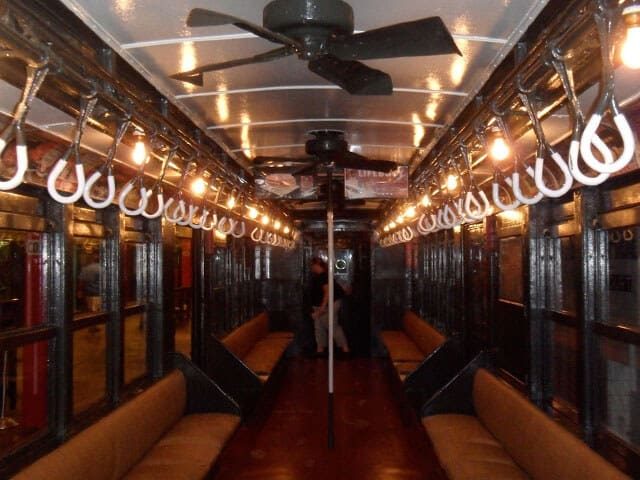
Welcome to the Brokelyn Files where our resident unlicensed P.I. Sam Weiss answers the local questions you never thought to ask. Got a lead on a Brooklyn mystery? Write us in the comments below.
Every year it happens; what was once a bastion of warmth in an icy tundra becomes the literal (well, not literal) depths of hell. The New York City subway in the summer is hotter than a southern euphemism and sure, there’s air conditioning on the train, but what about when it breaks? What about when it’s so hot that it doesn’t matter? What about that terrible station that feels a good twenty degrees warmer than the street? This week, the Brokelyn Files asks why; why is it so hot down there? Why do the air conditioners always break? Why do the stations get so unbearable? WHY MUST WE LIVE LIKE THIS!?
First off, we New Yorkers certainly enjoy a good complaint, so how hot is it really down there? Well, hot enough that the MTA has a special name for the phenomenon of cars overheating — “Hot Cars” (stolen from my Pixar fanfic) — and a twitter account — @NYCTSubway — that, along with reporting power outages and track maintenance, serves as a sounding board for complaints about those “hot cars.” The MTA promises to address overheating cars flagged up on that account, but flipping through tweets @NYCTSubway, you’ll see complaint after complaint about subway cars overheating, all summer long. Between 2010 and 2014, the MTA received 6,500 complaints about hot cars, according to The New York World, reaching a monthly peak of 504 complaints in July 2013. And as WNYC reports, those hot cars sometimes take the MTA dozens of complaints and several weeks to fix. Several long, sweltering, sweaty July weeks. Meanwhile, the stations themselves are not much better. WNYC collected temperature data on stations throughout the city in July 2015 and found stations as hot as 106.6 degrees (namely, the City Hall 4/5/6 platform). So yeah, it’s not just you, the subway really is that hot.
________

So, why is this happening? And why is it so difficult for the MTA to fix? Does Governor Cuomo just want my back that sweaty? The short answer is no, it’s hot because the subway is very, very old. The subway was an incredible feat of technology when it was built in 1904, but it also used to just have regular ceiling fans and vents to push hot air out. The first subway car to get air conditioning was in 1955, and while A/C technology has greatly improved since then, some of the trains on which we still ride are almost as old as that very first one. The oldest train still operating, the R32, which still makes up part of the A, C, J and Z fleets, have been running since 1964. Unsurprisingly, the R32 had more complaints than any other unit in that 2010-2014 survey, because, well, they’re half a century old. And, while, the MTA regularly retrofits and upgrades its trains, at a certain point a train from 1964 is just a train from 1964.
As the MTA itself points out, A/C technology has changed. While each train receives “an extensive scheduled maintenance system overhaul”(including cleaning, testing and replacing A/C parts) every 14 years, some of the trains are built on such old technology, they still consistently break down. MTA spokesperson Kevin Ortiz explained to WNYC, “The technology at the time provided for one compressor for each of the air units in the car. So if you lost that one compressor, you basically lost all of the air for that entire car. [Now] they have separate HVAC systems, where if one fails, you can use another within that car, [and they] are easily removable from the top of the trains. That’s not the case with the older technology cars, where you have to work on the entire component as a whole to address it.”
Besides just being outdated, the subway also struggles more when trains are especially crowded and full of body heat and with lines like the C-train, which never go above ground (staying underground without enough ventilation makes the train’s A/C work overtime and, it’s not in your head, break down more on those lines). There’s also the chance that you’re riding on a car at the end of that 14-year cycle, only at the tail end of which does the MTA do a repair overhaul. So, while the subway A/C systems are regularly repaired, it might not have gotten a nice deep clean and servicing since you were in high school. Luckily, WNYC (the leader of the pack on the hot train beat, if you haven’t noticed) took all that into account and made a handy field guide to determine if your subway train is especially likely to overheat.
________
There’s also the fact that A/C units produce heat, which warms the whole system, especially the subway stations. As the MTA’s Adam Lisberg told Gothamist, “The platforms are hot. You’ll notice the trains have air conditioning. But making the trains cooler requires pumping the hot air out… and [the hot air] ends up in the stations.” So, the cruel irony, then, is that the very thing that’s supposed to make your ride more bearable is actually making your wait several degrees warmer. Those stations, by the way, are often decades older than the cars themselves, not to mention larger and just as crowded. Thus, that drip of back sweat as you wait for the G.
The last reason why the subway seems to get hotter and hotter is because the Earth is getting hotter and hotter. The MTA put out a report a few years back about the future of transportation and noted that climate change is actually effecting the subway. The MTA Transportation Reinvention Commission Report says that “already hot underground subway platforms and stations could become even hotter” and, even more worrisome, that “extreme temperatures, particularly rising temperatures in the summer months, can stress the MTA system. At higher temperatures, expansion joints on bridges and highways are stressed, and instances of rail track stresses and track buckling increase.” So, the good news is that the MTA knows it’s a problem and is working on it, but the more terrifying news is that the heat is actually tearing apart the tracks and bridges.
So, why is the subway so hot? Well, a bunch of reasons: because much of the subway system is very old, like, older-than-the-popularization-of-air-conditioning-old; because the city and planet are getting warmer; because it’s difficult and expensive to cool a crowded train that never goes above ground or a giant subway station; and because, they’re working on it, OK!?
Leave a Reply



